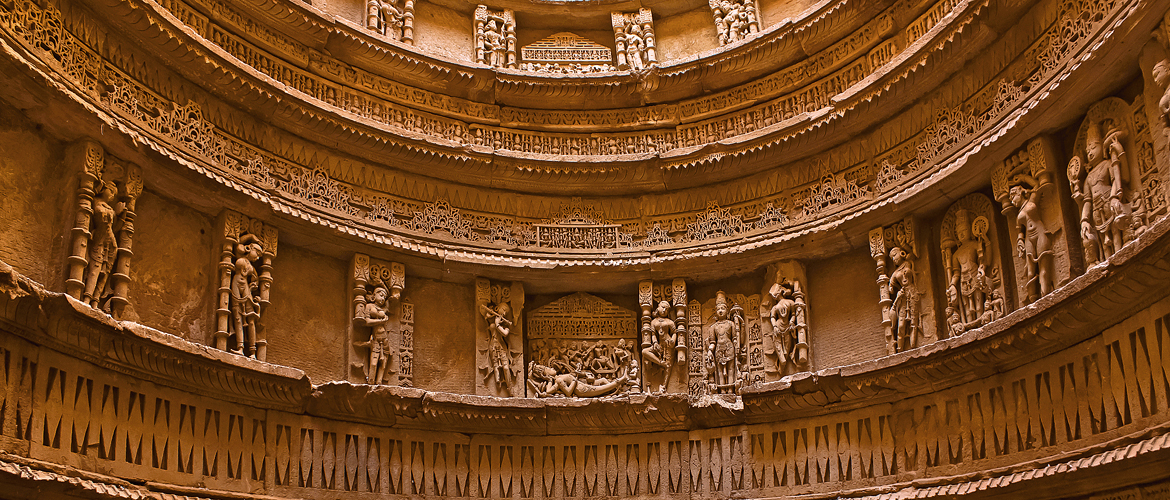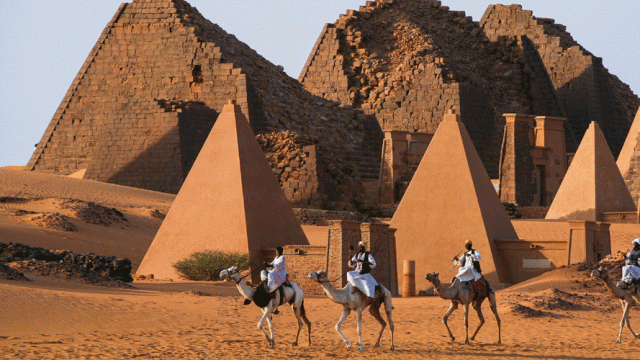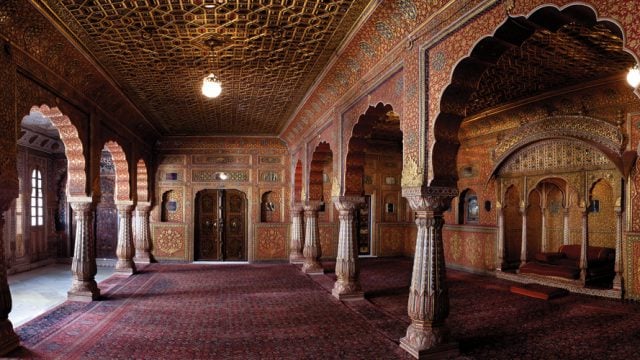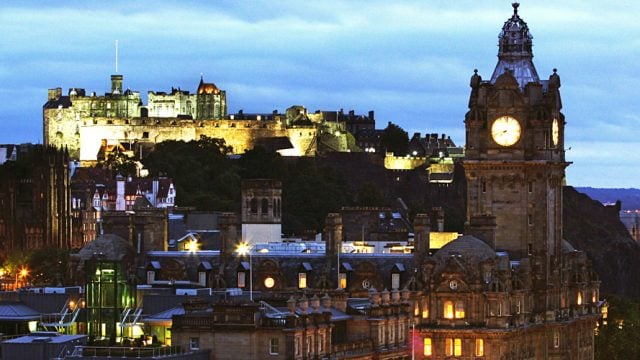A very Calcuttan thing to do every year is to visit the beach town of Puri nestled
This time, as soon as I entered the darkened weather-beaten complex of intricately carved stone, a testament to time, I had the strangest déjà vu—I was back in the tiny village of Modhera located at the other side of the country. Reminiscing about the lesser-known (as some would say) Sun Temple in Gujarat was fascinating given how two very different regional architectural structures had sprung up in opposite parts of the subcontinent within the same time frame and were dedicated to the same Vedic deity—the sun god Surya.
Last year, when I was writing my thesis on Pichvais, the beautiful cloth paintings that hang behind the idol of Srinathji in the temple at Nathdwara and in the homes of devotees, a visit to Gujarat and Rajasthan seemed necessary. Researching and conducting field work in the month of May in Ahmedabad is definitely not ideal, but I used my free time to experience the diverse variety of architecture, textiles and food the city had to offer. As a student of art history, I had read about the architectural styles that had coexisted in this part of the country. Having come this far, I knew I’d absolutely regret not visiting the Sun Temple of western India, especially after writing an essay on it in college. After considering student-friendly options of taking a bus and travelling the local way, I succumbed to the heat and opted for a comfortable taxi. It turned out to be a good decision because I had the most interesting driver who was also a great conversationalist. He narrated stories and legends of the region’s history.
The day-long trip I had planned included two historical sites and covered a distance of nearly 300 kilometres. The road cut across contrasting sceneries of quaint villages and industrial hubs. We first drove to Patan, which was originally built as a fortified city in the eighth century by the Chavda dynasty. The city is famous for two things—the ornamented stepwell known as Rani ki Vav and the ancient textile tradition of patola.
Given the sporadic and scarce rainfall received in western India, stepwells are pretty much ubiquitous here. Innovative water storage and harvesting methods were thought of and placed within elaborate structures. Stepwells had different names in different areas—vav, boali, bavadi and so on.


Rani ki Vav, one of the deepest stepwells in India, is located within a complex of stone paths cutting across sprawling well-manicured lawns. As you approach the centre of the park, you catch a glimpse of a strange elongated crater. I wasn’t quite sure what to expect and was awestruck by the richly ornamented multi-tiered stepwell as I descended the high steps leading into the crater. I think it was the inconspicuous setting leading to an unexpected architectural wonder that really ignited my senses.
Resembling an inverted temple, the stepwell was built by Queen Udaymati in the 11th century in memory of King Bhima of the Chalukya dynasty. A tribute quite apt given the symbolic sanctity and sacredness attached to water. The walls are divided into horizontal registers covered in sculptures and panels representing different religions, mythologies and social scenes. One can only gasp in admiration at the talent, aesthetic sensibilities and dedication of the craftspeople and engineers who created this masterpiece without the help of modern technology. What was truly fascinating were the panels of geometric motifs in checks and diamonds, which are also found in the patola saris of the region—an example of how art forms borrow from one another. A similar trend is also seen in the figurative motifs of the Baluchar textiles of Bengal, which have been borrowed from the surrounding terracotta temples. Even though only a small section of the stepwell is accessible to tourists, the seemingly never-ending rows of carved pillars are a sight to behold.

I was slightly apprehensive about visiting the temple next. What if it was overshadowed by the magnificence of the stepwell, even though they were completely different structures? Heading back to Mehsana district, as I approached the charming village of Modhera, the urban landscape was replaced by tree-lined roads and simple homes on either side.
After a short walk from the car park, I was greeted by the profile of the Sun Temple, reflected in the green waters of the kund or tank before it. As I walked in with other tourists and locals, I was stunned into silence by the temple’s grandeur. It was not as immense like the one in Odisha, but it had a strong retrospective quality. The silence of the water, the structure and the people around it were oddly comforting.

The east-facing Surya or Sun Temple at Modhera is the earliest dated temple in Gujarat, having being built in 1026 CE, as per the inscription found at the site. Like the Sun Temple in Konark, the one in Modhera is not a living temple. It comprises three parts, built in the Maha-Gurjara style.
The beauty of Indian architecture lies in its ability to borrow from various artistic trends across regions and borders, and adapting those styles to create something unique. The chariot-like structure of Konark, for example, is replaced by three individual yet-connected structures that form the home of Surya in Modhera.
The first section is made up of the rectangular stepped tank, commonly known as Surya or Rama kund. An interesting aspect of the kund is that it is marked by 108 miniature shrines at different levels, which can be accessed by staircases found all around the tank. I walked around, taking in the exquisitely carved deities, but was unable to view all the shrines.
Each one had its own individual charm and was a precursor to the beauty of the main part of the temple that lay ahead. From afar, the geometric projected sandstone shrines were a contrast to the calming plain waters now home to vibrant aquatic life. Philosophically, the placement of the tank is quite apt because it is mentioned in the Vedas that the birth of the sun was from the great cosmic waters. Beyond the tank are remnants of an ornamented pillared gateway known as the kirti torana, which leads to the next structure known as ranga mandapa or sabha mandapa.

The exterior of this open-pillared hall topped off by a linear roof is covered in sculptures and panels depicting deities, social scenes, flora and fauna, and geometric motifs. It is a testament to the artisans’ skill that each element transitions harmoniously into the next one, allowing every viewer to create their own narrative. Amorous couples are placed in rows, while divinities belonging to both the Vedic and Puranic pantheons decorate other sections of this hall. The dense richness of the exterior is mirrored on the pillars and ceiling inside. Each pillar is topped off by stalky figures, their extended bodies stylised as though the entire weight of the temple is on their shoulders. The light streaming in from the open cavities illuminating the ornamented pillars that represented scenes from the epics, battles, hunts and festivities are especially captivating.
The ranga mandapa leads to the main shrine of Surya known as the gudha mandapa, which is further divided into three parts—the assembly hall, the vestibule and the sanctum sanctorum or garbha griha. The statue of Surya used to stand in the last section, sparkling in the rays of the sun on particular days. Once again, an example of true architectural ingenuity. On the garbha griha once stood a towering spiral, which has now crumbled to its base.
As the day came to an end, I found the perfect shaded spot on the side of the temple. There were a few of us waiting to see the last rays covering this sandstone wonder, and I could only imagine what a spectacular sight it must have been when the main idol used to be illuminated by the sun during an equinox.
The Information
Getting There
The closest airport to Modhera is Ahmedabad, which is well connected to different parts of the country by regular flights. It takes about two hours by road to reach Modhera from Ahmedabad. The most comfortable option is taking a taxi because it gives you the flexibility to make an independent itinerary. I had asked my hotel to arrange it for me (₹3,000 for the whole trip, food and tips excluded). Another option is to take a bus to Mehsana and then another to Modhera.
Where to Stay
Ahmedabad has stay options across all budgets. I would recommend a stay at the pols (in the old walled city) where many old havelis have been converted into boutique hotels. French Haveli (from ₹2,500 singles; frenchhaveli.com) and the Dodhia Haveli (from₹5,000 doubles; frenchhaveli.com/dodhia-haveli-hertiage-suites) are two such options.
Where to Eat
It’s best to eat a meal in Ahmedabad and carry snacks with you for the long road journey. One will come across various dhabas and roadside eateries and they usually serve vegetarian fare.
Sun Temple
Modhera
Gujarat





